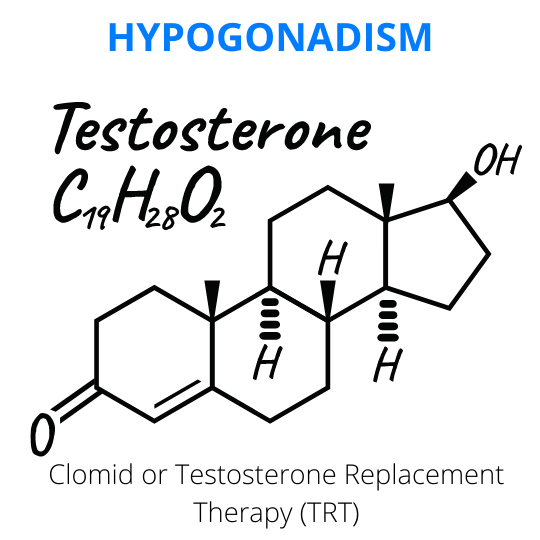Male hypogonadism is a medical condition in which the testicles do not produce enough testosterone. Symptoms include reduced sex drive, erectile dysfunction, fatigue, and hot flashes. In some cases, there may also be decreased muscle mass and bone density.
Male hypogonadism can be caused by a variety of factors, including genetic defects, infections, injuries, and certain medications. Treatment typically involves testosterone replacement therapy. Clomiphene citrate is, however, a reasonable alternative in patients with an intact hypothalamic-pituitary-gonadal axis – meaning the brain’s ability to regulate testosterone production is intact.

What is testosterone
Testosterone is a hormone that plays an important role in the development of male characteristics. Testosterone levels typically peak during adolescence and early adulthood, but they can begin to decline as men age.
Testosterone therapy for hypogonadism
Testosterone therapy is used to treat a variety of medical conditions, including hypogonadism and delayed puberty. However, the therapy can also cause a number of side effects, ranging from mild skin irritation to more serious health problems. The most common side effect of testosterone therapy is local site reactions (sites of injections or topical testosterone application).
Other side effects include acne, which can occur on the face, chest, and back. In some cases, the acne may be severe enough to require treatment with oral antibiotics. Other common side effects include increased red cell count (risk for blood clots), worsening sleep apnea, changes in mood, increased hair growth, and fluid retention. In rare cases, testosterone therapy can lead to more serious health problems such as heart disease and liver toxicity. Use of testosterone therapy is associated with a significant reduction in sperm count.
It can be thought of as a male contraceptive. If you intend to start a family as a cis-gender man, treatment with testosterone is not the way to go. Indeed, if you were to stop testosterone in anticipation of starting a family, you would need a few months to allow your own testicles to produce an adequate amount of sperm. Sometimes you may require alternative therapies to increase your sperm count. As a result, it is essential to discuss the potential risks and benefits of testosterone therapy with a healthcare provider before starting treatment.
Testosterone preparations
There are a number of different testosterone treatment options available. Testosterone replacement therapy is one of the most common and effective treatment options. This involves taking synthetic testosterone supplements to replace the lost testosterone in your body. Testosterone gels, patches, or injections are just some of the many testosterone treatment options available.
Gels: One relatively new treatment option is testosterone gel. This gel is applied to the skin, where it is absorbed into the bloodstream. Testosterone gel has been shown to be effective at raising testosterone levels, but it can cause skin irritation and other side effects. Testosterone gel is typically applied once daily to the shoulders, upper arms, or abdomen. It should not be applied to the genitals (cisgender men) or breasts (for transgender males transitioning from female to male).
Injections: Injections are usually administered every two to four weeks. While testosterone replacement therapy can effectively treat some of the symptoms associated with low testosterone levels, it can also cause side effects, such as acne, mood swings, and irritability. Patients on this testosterone preparations are more likely to experience an increase in their red cell counts – a major risk factor for blood clots. Your endocrinologist will routinely monitor the adequacy and safety of testosterone treatment by monitoring your hormone levels and blood counts.
Patches: Another popular method of testosterone replacement therapy (TRT) is the use of testosterone patches. These patches are typically applied to the arm or shoulder once or twice a day, and they deliver a steady stream of testosterone into the bloodstream. In addition to increasing energy levels and libido, testosterone patches can also help to build muscle mass and improve bone density. For many men, testosterone patches are a safe and effective way to combat the effects of age-related testosterone decline.
Clomiphene citrate (Clomid) for hypogonadism
Clomiphene citrate (CC) is a well-known drug that has been used for many years to treat female infertility. However, recent studies have shown that CC is also effective in treating male hypogonadism. Male hypogonadism is a condition in which the testicles do not produce enough testosterone. This can lead to problems such as infertility, low sex drive, and bone loss. While there are several approved treatments for hypogonadism, clomiphene citrate is often used “off label” due to its relatively low cost and lack of serious side effects.
A recent study showed that CC was able to increase testosterone levels in men with hypogonadism by up to four times. This suggests that CC could be a very effective treatment for this condition.
Mechanism of action of clomiphene citrate
The mechanisms by which clomiphene citrate increases testosterone levels are not fully understood, but it is thought to work by stimulating the release of gonadotropins from the pituitary gland. Review the normal hypothalamic-pituitary-gonadal axis here (for medical professionals).
Clomiphene citrate is a medication that is commonly used to treat male hypogonadism. It works by stimulating the release of gonadotropins, which are hormones that help to regulate the production of testosterone. In men with hypogonadism, the body does not produce enough testosterone, which can lead to a number of symptoms such as fatigue, decreased muscle mass, and sexual dysfunction.
Clomiphene citrate helps to increase levels of testosterone in the body, which can improve these symptoms. The exact mechanism of action is not fully understood, but it is thought to work by binding to estrogen receptors in the brain, which in turn stimulates the release of gonadotropins. Clomiphene citrate is generally safe and well-tolerated, but it can cause side effects such as hot flashes, headaches, and nausea.
| Clinical Effect | Clomid | TRT (IM Injections) |
| Libido | More sustained libido | Fluctuates throughout an injection cycle. |
| Testosterone levels | Steady throughout a treatment cycle | Fluctuates throughout a treatment cycle |
| Erythrocytosis (risk for blood clots) | Low risk | High risk |
| Fertility | Preserved | Lost (significant decline in sperm count) |
Reference
Clomiphene citrate is effective in treating male hypogonadism. Fertil Steril. 2012 Oct;98(4):1148-53.e1-5.
The opinions expressed here represent the views of a practicing hormone specialist (endocrinologist) and must not substitute the advice of your health care provider. This blog post is written for a non-medical audience interested in learning more about hormonal disorders. The author has no commercial conflicts of interest to declare. Also, read our privacy policy.
Kindly Let Us Know If This Was helpful? Thank You!


